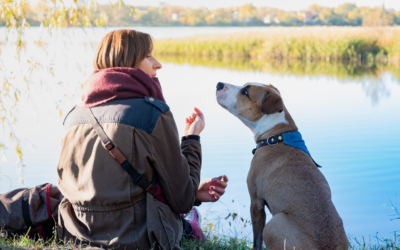You may have heard that it’s National Dog Bite Prevention Week®. If you have a dog in your home, or if you’re ever in contact with dogs, this week is an important reminder of the importance of safety around dogs. This is especially the case if your dog is ever around children.
We share our homes with our dogs and they're an important part of our families, and it can be hard to believe they could bite someone. If you have children and they have a great relationship with your dog, you may not consider that they don’t know how to interact with a strange dog uncomfortable with children.
How common are dog bites?
Unfortunately, statistics on dog bites are few and far between. Those that are published are likely underestimates as the majority of dog bites are not reported.
When I was a young child I was bitten by a neighbour’s dog and I know it wasn’t ever reported. Typically, only serious bites resulting in the need for medical attention are ever recorded.
In saying that, it has been estimated that 4.5 million people in the US are bit by dogs per year (Sacks et al., 1996; Gilchrist et al., 2008). According to the American Veterinary Medical Association, there were over 350,000 reported dog bites to children between 2010 and 2012 in the US. Of children, toddlers are the most likely to be bitten, with the risk gradually decreasing as children get older (Schalamon et al).
Why do dogs bite?
Dogs can bite for many different reasons. Most dogs show some other form of behaviour before they resort to a bite. Punishment for behaviour such as growling can cause dogs not to show these signs when uncomfortable, which is very concerning.
Dogs can bite when protecting territory, resources, or they're young; or when they’re afraid, just to name a few. Dogs do not bite because they think they are the alpha over other members of the family (we’ll deal with this in another post).
Young children may be more at risk for many reasons:
- They’re often at the same level as dogs
- They don't know how to read signals a dog might be giving
- They may approach dogs in situations where they would be more likely to bite
- Their behaviour can be unpredictable to dogs
- Any many more…
how can we prevent dog bites?
It is incredibly important that adults and children learn how to:
- Recognize situations in which dogs shouldn’t be approached
- Learn how to read dog behaviour – especially less obvious signs that a dog is uncomfortable or fearful
- Manage and supervise carefully when dogs are around children
Many people are aware of overt signs of aggression in a dog and wouldn’t approach a dog that is growling, baring teeth, lunging and barking. Children need to be taught about these signs, what they mean and what they should do. However, the subtle signs that a dog is fearful often go unnoticed.
Unfortunately, many of the pictures floating around the internet of kids and dogs also have signs that dogs are uncomfortable.
For example, in the picture below, what can you see about the dog that might let you know how they feel about this situation?

To name a few:
- The dog is leaning away from the younger child
- The dogs’ ears are pinned back
- You can see the whites of the dogs’ eye, often a sign that they are fearful
These signs don’t necessarily mean that this dog is about to bite the young child. However, depending on the personality of the dog, the situation they’re in, and the history the dog has had with children, this situation could place the child at risk.
What can you do to start?
It’s VERY important to talk to children about dog safety and model appropriate behaviour that you would want them to mimic.



